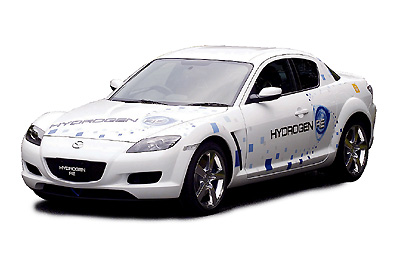| October 14, 2003 |
Mazda to Unveil Two-Seat Sports Car Concept and Hydrogen Rotary Engine at 2003 Tokyo Motor Show
- Mazda's theme at the 37th annual Tokyo Motor Show: 'Zoom-Zoom to the Future' -
Mazda Motor Corporation zooms into the 2003 Tokyo Motor Show with the strongest line of production and concept cars in company history, including the world premier of the two-seat Ibuki concept, an open-top, lightweight sports car that hints at a possible design direction of a future Mazda Roadster. Joining the Ibuki concept on the stand are key environmental technologies being developed by Mazda such as the unique RENESIS hydrogen rotary engine (also a world premier) and the company's latest production models, including the all-new Mazda Axela.
The 37th Tokyo Motor Show will be held at the Makuhari Messe Convention Center in Chiba City and open to the public from Saturday, October 25th to Wednesday November 5th, 2003. Mazda president Hisakazu Imaki is scheduled to host a press briefing at the Mazda stand in the Makuhari Messe Central Hall on Wednesday, October 22nd from 14:10 to 14:30. Mazda's theme for the 2003 Tokyo Motor Show, "Zoom-Zoom to the Future," highlights the continuing evolution of the company's Zoom-Zoom spirit, embodied by the consecutive successes scored by Mazda's new-generation vehicles: Atenza/Mazda6, Demio/Mazda2, Mazda RX-8 and the newly-introduced Axela/Mazda3 have all received critical acclaim from media and customers in markets around the world and are helping drive Mazda's current sales success. With this year's theme, Mazda is also emphasizing its intention to continue delivering "exciting and exhilarating driving experiences" to its customers.
Major vehicle and other exhibits
Outline of main exhibits Powered by a MZR 1.6-liter, four-cylinder engine, the Ibuki concept successfully realizes a super front-midship layout (as also found in the Mazda RX-8) that places all major components within the wheelbase. Compared with the layout in the current Mazda Roadster/MX-5, the engine is positioned approximately 400mm further to the rear, while the air conditioner unit is located behind the seats. Thanks to the super front-midship layout, yaw inertia moment has been greatly reduced, enhancing further the level of pure, fun drivability-oneness between car and driver-that has been central to the Roadster's ongoing success. Mazda 'Kusabi' concept The concept features innovative packaging solutions such as the Twin-Lift Hatchback design that features dual hatches with two opening modes: a longitudinal hinge in the center of the roof allows individual opening of the hatches from either side of the car, or they can be opened together, from the rear, in the conventional hatchback manner. Employing the 1.3-liter supercharged MZR engine equipped with an idle-stop mechanism, the Kusabi concept presents Mazda's proposals in terms of practicality, driving performance and environment- friendly features. Mazda 'Washu' concept The Washu's interior incorporates concepts and forms found in traditional Japanese architecture, giving the cabin comfort and flexibility. In addition, innovative "airplane doors" and a deployable instrument panel equipped with a retractable steer-by-wire steering wheel greatly enhance ease of entry and exit. Taken together, these unique measures allow Mazda Washu to offer values not found in today's multi-purpose vehicles. Mazda Roadster Turbo concept The turbocharged engine has been tuned to retain the Roadsters smooth and linear power delivery, with a flat torque curve that offers consistent and strong torque from 2500 to 5500 rpm. Mazda Roadster Turbo also features enhanced drivetrain components including a taller final-drive ratio (now 4.100, up from 3.910) and an upgraded limited-slip differential. The Roadster Turbo's suspension has been upgraded with larger-diameter anti-roll bars, larger tires, stiffer dampers and springs rates 20 percent firmer than normally aspirated models, helping reduce pitch and roll. Overall, the Turbo's body has been lowered by 10 mm compared to the normal Roadsters. 2. Technology exhibits In addition to direct hydrogen injection into the intake chambers via two electronically-controlled injectors per rotor, the Mazda RX-8 Hydrogen RE features a dual-fuel system allowing one-touch switching between either hydrogen or gasoline, promoting the car's versatility as a hydrogen fuel infrastructure is developed. Other environmental-friendly features applied to the vehicle include a plant-based plastic for interior parts and an application of three layer wet paint system. Mazda is also presenting advanced technologies including a hybrid system with electric torque assist and start-stop technology, and a turbocharger with electric motor assistance-technologies that will contribute to future enhancement of hydrogen rotary engine performance. MZR 2.0 PZEV engine New MZR-CD engine [Safety-related topics] Safe-driving support with regard to fatigue 3. Current production model The bold design is attractive from the very first glance, while its refined sophistication continues to please the eye over time. The four- and five-door versions have noticeable design differences, yet both fascinate with their style. New-generation craftsmanship realizes a new standard of quality which enhances both the delight of ownership and the pleasure of driving, while the efficient packaging achieves true versatility in practical use, excellent maneuverability, and a sleek exterior appearance. In addition, Axela offers world-class safety plus superbly clean performance, proven by the Japanese U-LEV certification awarded to all models. Axela's unprecedented values set an entirely new global standard for compact cars. |
||||||||||||||


